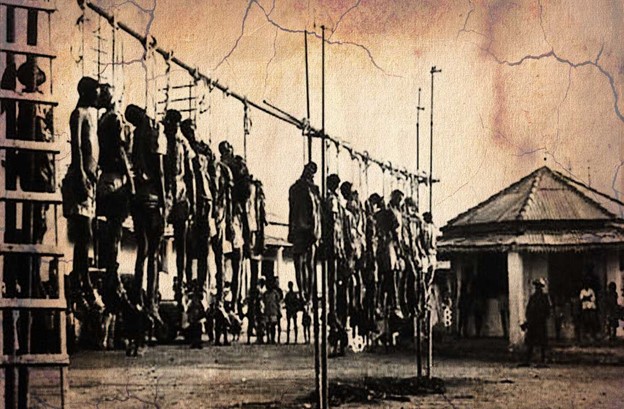For the past two centuries, successive Ethiopian expansionist rulers have committed untold crimes against the people of Eritrea. As we celebrate the 33rd independence of Eritrea, it is paramount that we remember those Eritreans who were massacred by the savage Ethiopian rulers and the heroic liberation fighters who sacrificed their lives for a free and independent Eritrea. The events and pictures below depict real stories, including cruel amputations, public executions, village massacres, and other atrocities.
Figure 1: In March 1, 1896, during the Battle of Adwa, captured Eritrean Italian Askari soldiers were subjected to amputation of one leg and one hand by Ethiopian rulers. The white Italian soldiers were set free unscathed.

Figure 2: On July 24, 1967, Ethiopian soldiers wiped out several villages in Hazemo, Eritrea, and brutally murdered 172 men in front of their families.

Figure 3: On January 17, 1970, Ethiopian soldiers rounded up and executed sixty village elders in Ela bared, Eritrea.

Figure 4: November 30, 1970, Ethiopian soldiers rounded up the entire village of Besikdira, Eritrea, forced the residents into the local mosque, and opened fire until almost all were dead, including the elderly, women, and children.

Figure 5: In 1971, about 70 students and youth In Keren, Eritrea; suspected of supporting the ELF were publicly executed by hanging, with their families forced to witness the barbarity.

Figure 6: On December 1st, 1974, at Ona, more than 800 residents and refugees from surrounding villages, notably Besikdira, Eritrea, were massacred by the Ethiopian army.

Figure 7: On March 9, 1975, following ELF attacks on Agordat, Eritrea, the Ethiopian Army retaliated by killing 258 civilians.

Figure 8: On February 2, 1975, during a confrontation with the EPLF and ELF in Wekiduba, Eritrea, the Ethiopian Army attacked a church where civilians had sought refuge, resulting in the deaths of 103 innocent people, known in Eritrea as Black Saturday.

Figure 9: February 24, 1975, shortly after an EPLF attack, Ethiopian troops massacred about 3000 civilians gathered in churches, homes, and schools, in Asmara and also executed 70 students by strangulation.

Figure 10: In May 1988, 400 people, mostly women and children, were crushed to death by tanks in the village of She’eb, Eritrea.

Figure 11: On April 24, 1990, in retaliation for a defeat in Massawa, the Ethiopian Army conducted an air attack, killing 50 civilians and injuring 100.

Figure 12: Between 1998-1999, the TPLF-led Ethiopian government expelled 80,000 Eritrean civilians, confiscating their properties.

Figure 13: During the 1998-2000 War, Ethiopian soldiers destroyed newly constructed telecommunications buildings in Senafe, Eritrea.

Figure 14: During the 1998-2000 War, Ethiopian soldiers destroyed a newly constructed hotel in Barentu, Eritrea.

Figure 15: During the 1998-2000 War, Ethiopian soldiers dug up the Eritrean Martyrs Cemetery in Shambuko and scattered the remains.

Figure 16: During the 1998-2000 war, Ethiopian soldiers intentionally destroyed private homes using artillery and dynamite.

Conclusion:
The above pictures and events represent only a fraction of the atrocities committed by successive expansionist Ethiopian rulers against the people of Eritrea. Despite these injustices, Eritreans have shown resilience and unity in their struggle for independence. As we celebrate Eritrean independence, let us remember the sacrifices of our martyrs and renew our commitment to justice and freedom.
“Victory to the Masses and Eternal Glory to Our Martyrs.”
